There are twenty three (23) good companion plants for cantaloupe in this list along with ten (10) plants you should avoid. Cantaloupe is also known as rockmelon, spansek or sweet melon. It is a variety of a species known as muskmelon within the cucurbit or gourd family Cucurbitaceae.
This summer fruit comes in several sizes and weights, being anywhere from 0.5 to 5 kg (1 to 11 lbs). Two cultivars of the cantaloupe are popular: the European (Cucumis melo var. cantalupensis) and the North American (Cucumis melo var. reticulatus) cantaloupe.
The European cultivar “is lightly ribbed with a sweet and flavorful flesh and a gray-green skin” while the other one, the North American cultivar, “is a different variety… with a reticulated (“net-like”) peel. It is a round melon with firm, orange, moderately sweet flesh.” (Wikipedia)
Both can be eaten as fresh fruit, in salads or as dessert with ice cream or custard. Their edible seeds may be dried and used as snacks. This consumption should be done after the fruit is thoroughly scrubbed and cleaned to avoid bacterial infections.
A raw cantaloupe is made up of 90% water, 8% of the fruit is carbohydrates (way more sugar than fiber) and there are trace amounts of protein (0.8%) and fat (0.2%).
It contains several vitamins and minerals. These include the vitamins A, B1, B2, B3, B5, B6, B9, C and K, choline, calcium, sodium, potassium, phosphorus, manganese, iron, magnesium, and zinc.
Similar to many other plants within its family, the cantaloupe plant is a sprawling one. It requires warm, fertile, well drained soil, lots of sunlight, plenty of water for the soil (but not too much that it gets soggy) and adequate spacing.
There are several other crops which may be planted with the cantaloupes in your garden to encourage their growth, help keep pests away from them, attract useful insects to them, help the soil with nutrients, maximize garden space or shade them from excess sunlight.
Such grouping for the purpose of sharing benefits is called companion planting. It is a tried and true method, ensuring that crops are grown around other crops that help foster their growth. As the good and bad companion plants are listed below, reasons why they are so are also given.
Table of Contents
Good Companion Plants for Cantaloupe
1. Basil
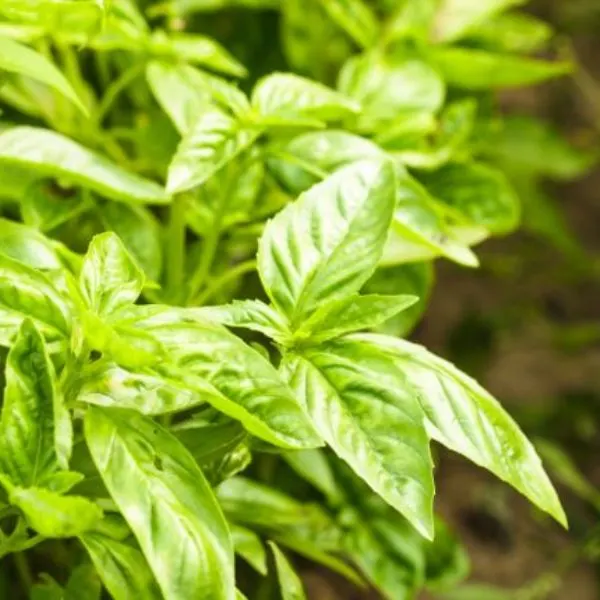
Basil is a herbaceous flowering herb belonging to the mint family Lamiaceae. Also referred to as great basil, it has a sweet, spicy and slightly peppery flavor. It is cultivated for its leaves and flowers that are used for food in several cuisines.
The seeds of this culinary herb may also be soaked for use in drinks and desserts. Just like other herbs, basil is very aromatic and has a strong smell. It contains oils in the leaves that can be released by gentle touch.
Basil serves as a good companion for cantaloupe because it can help repel the whitefly, one of the major pests of cucurbit plants. Just as many other herbs, basil plants are compact and small in size. For this reason, they do not shade your cantaloupe vines while they are young and growing.
2. Beans
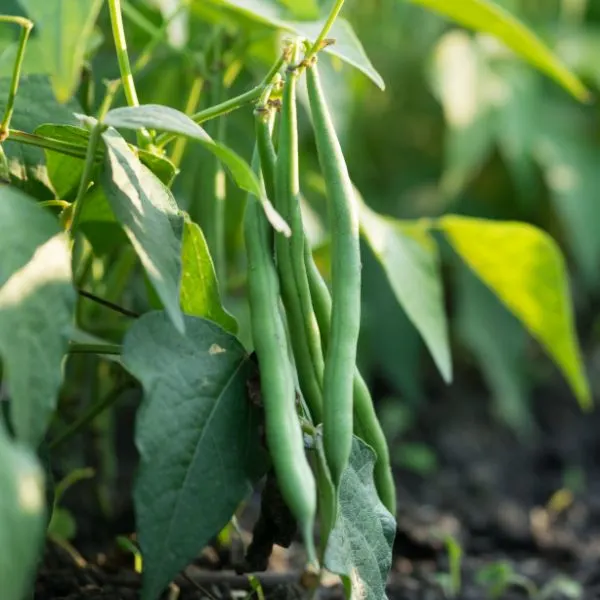
Beans are seeds of several genera of flowering plants that belong to the botanical family Fabaceae (the pea family). Bean seeds (pulses) are then boiled, fried, baked or cooked by some other method and used as vegetables for humans or animals to eat.
Beans are some of the best companion plants for cantaloupes because they are legumes, plants with nodules in their roots that help fix atmospheric nitrogen in the soil. They improve the quality of the yield of other plants because they supply nutrients to the soil.
Cantaloupes are heavy feeders so they need leguminous companions like beans to enrich the soil. Bush beans mostly (because pole beans can shade your plants) will help to naturally fertilize your plant through the season.
In the same vein, planting bush beans with your cantaloupe maximizes the space in your garden. Bush beans do not block off the sun from your vining melons but instead give them enough room to spread out and grow well.
An important thing to note is that legumes and alliums are not the most compatible families to be planted together in the garden bed. However, plants within these families are very good companions for cantaloupe.
If you are planting beans near your melon crop, avoid growing any alliums in that area. Do not also add beans or any other legume to the companionship if alliums are already growing with your cantaloupe.
3. Bee Balm
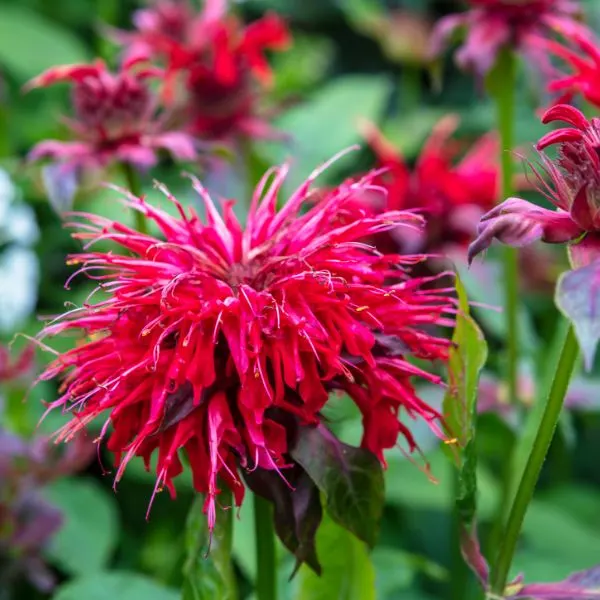
Bergamot, horsemint or bee balm is a genus of flowering plants, Monarda, in the biological family Lamiaceae which is also known as the mint family. Plants in this genus are native to and only grow in North America.
Bee balm thrives whether kept under full sun like cantaloupe or in partial shade. They like to grow in soil which is watered evenly and regularly. They have beautiful white, red, pink, purple or purple green flowers.
The flowers of these plants are known to attract such useful insects as bees and butterflies to the area. They help the reproduction of plants by aiding pollination. They make your garden area more aesthetically pleasing with bright colors.
In addition to aiding pollination, the insects and animals that bee balm attract also act as natural pest predators. Bee balm itself can keep certain pests away with its pungent smell. The plant is very ideal for keeping squash bugs at bay.
This plant can ensure your garden space is more aesthetic, encourage pollinators and pest predators, keep pests off with its pungent odor, and be used to make essential oils for some homemade bug spray recipes.
4. Carrots

Carrots are good companion plants for your cantaloupe. They are edible root vegetables with usually orange taproots and green leaves at the top. Cultivars in white, yellow, red, purple and black also exist, with this root typically tapering.
These edible root veggies can enhance the flavor of your melon crop. The main issue with planting them side by side is that they are both susceptible to attacks from insects like aphids and carrot flies.
A solution is to grow herbs like mint and rosemary alongside the pair to control pests. Mint is a good repellent of carrot root flies, with a strong aroma that masks the scent of growing carrots. In doing so, it confuses these pests and gives young carrots a chance.
Rosemary masks the smell of carrots and so carrot flies would be unable to detect these plants. Carrots can in turn help your rosemary plants thrive by controlling the presence of weeds that compete for soil nutrients in your garden.
Controlling weeds is a benefit that cantaloupe plants also enjoy due to the presence of carrots in your garden. Be sure to add in any of the herbs mentioned above to the pair as you grow them in your garden.
5. Catnip
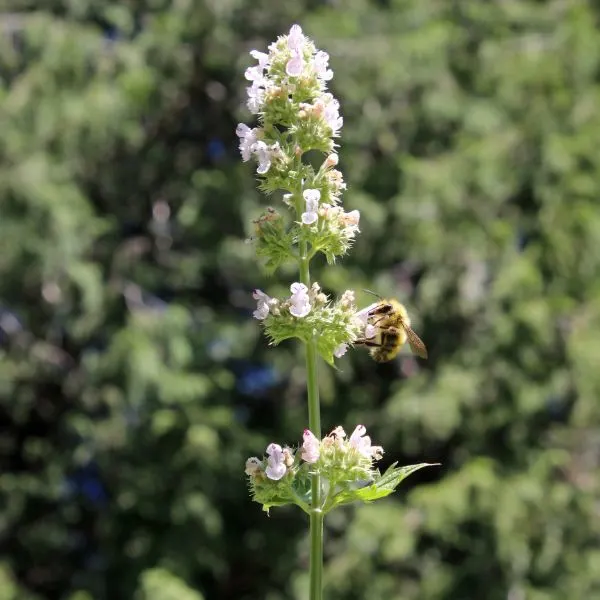
Known also as catmint, catnip is a genus Nepeta of aromatic herbs in the mint family Lamiaceae. There exist about 250 species of flowering plants in the family. They are native to Africa, Asia and Europe.
The plants are known as catnip or catmint because of the euphoric effect that the compound in most species, called nepetalactone, has on house cats. They have tubular flowers which may be blue, lavender, lilac, pink or white in color.
Catnip simply needs constant moisture until it becomes well-established in the soil. From then on, it is basically drought tolerant and very easy to care for. It also requires full sunlight, like cantaloupe, but it also grows well in partial shade.
The beautiful flowers of catmint plants mix very well with those of cantaloupe plants, so catnip is quite good as a companion plant for cantaloupe. When both plants are grown together, both flowers can attract even more pollinators to your garden.
In addition, catnip serves as a good pest repellent because of its strong aroma. It deters pests of garden crops, like aphids and Japanese beetles, cabbage loopers, cucumber beetles, flea beetles, leafhoppers and squash bugs.
Some herbs, including catnip and mint, tend to be invasive, growing with their vertical roots taking up space in the soil and competing with other crops for nutrients.
Cantaloupe is a heavy feeder, meaning that it requires lots of nutrients to grow properly. For this reason, be sure to plant your catnip in a container close by to ensure that it does not take over the space and fight for nutrients in your garden.
6. Chives
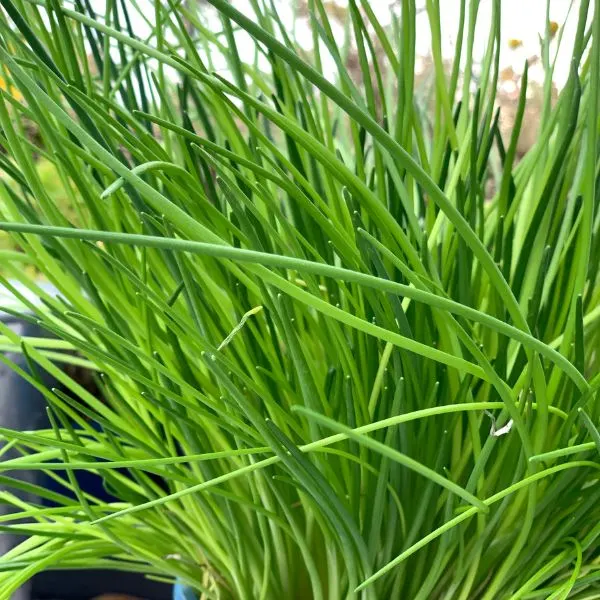
Chives are flowering plants in the genus Allium, just like garlic, leeks, onions and shallots. They are cultivated for the edible leaves and flowers they produce. Parts of the plants are then used as seasoning in food, with flavors of onion and garlic.
These plants serve as very good companions for cantaloupe. They have shallow roots that do not compete with your heavy-feeding melon for nutrients. They also have similar growth needs, liking full sun and lots of moisture.
Chives can however thrive in partial as well as in full sunlight exposure. As alliums, chives have sulfur in them. This sulfur content is the reason for their strong, insect-repellent smell. It is also a natural anti-bacterial compound and fungicide, making these alliums suitable for pest and disease control.
Some natural predators of cantaloupe like cucumber beetles and aphids can be repelled by garlic, chives and other kinds of alliums. Larger pests, like foraging rodents and deer, can also be deterred from attacking your cantaloupe by chives.
Chives also grow compactly and do not block cantaloupes from the full view of the sun. One important thing to note is that legumes and alliums are not the most compatible families to be planted together in the garden bed.
However, the plants within these families tend to be very good companions for cantaloupe. If you are planting chives near your melon crop, avoid growing any legumes in that area.
Do not also add chives or any other allium to the mix if legumes are already growing with your cantaloupe. This is because alliums can stunt the growth of legumes with their allelochemicals.
7. Corn
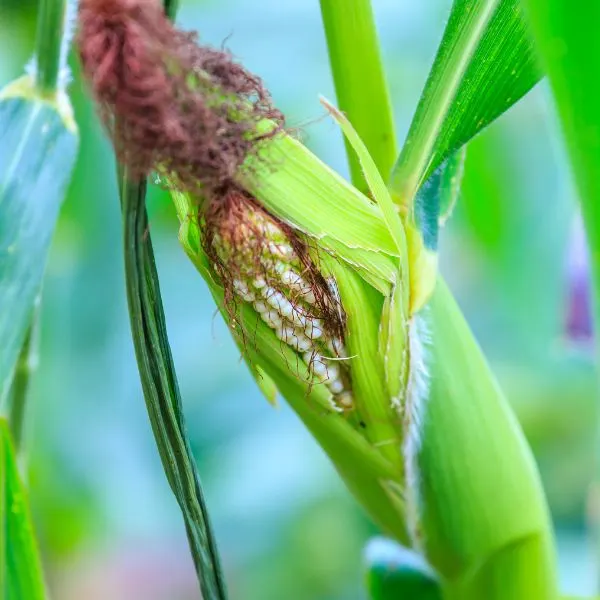
Corn or maize is a species of monocotyledonous flowering plants in the grass family Poaceae or Gramineae. Its leafy stalk produces separate inflorescences known as ears. When fertilized, these ears yield fruits, which are seeds.
The plant serves as a good companion to cantaloupe. It is tall and helps to suppress the growth of weeds. Because it grows vertically, the size of the maize plant may make it seem as though its roots are invasive.
However, this is not the case as the roots of maize plants are not invasive. Corn and cantaloupe plants are also compatible because they enjoy similar growing conditions: they prefer to be planted in full sun and watered regularly.
Corn can also protect cantaloupe plants from excessive heat from sunlight. Plant the taller corn on the sunniest side of your garden and grow your cantaloupes on the opposite side to give them a break from the harsh afternoon rays.
8. Garlic
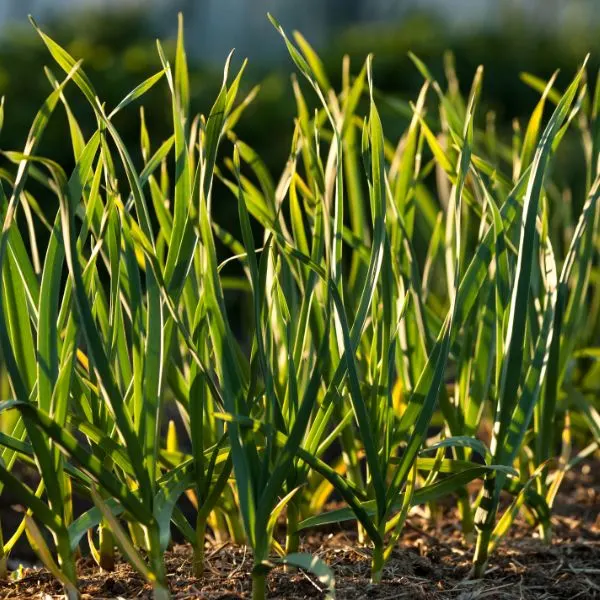
Garlic is a flowering plant in the genus Allium, alongside chives, leeks, onions and shallots. It produces a pungent or sharp-smelling bulb divided into cloves which is used to season food or make oil used by spraying to deter pests.
The oil made from this herb is known as garlic oil. It contains allicin, the chemical that lends it its smell and makes it effective for the treatment of several ailments. Garlic and other alliums are good companions for cantaloupes.
As an allium, garlic produces an antifungal sulfur compound and then releases this into the soil. This prevents fungal diseases like Fusarium wilt, root and stem rot by boosting the plant’s resistance to the soil-borne fungi that cause the aforementioned diseases.
The sulfur that garlic emits is a fungicide (a substance that helps protect your crops from fungal diseases). It can keep garden pests away, including cucumber beetles, aphids, deer, Japanese beetles, rabbits, snails, cabbage loopers and spider mites.
It has been established that cantaloupe loves the sun, so with the compact growth pattern of this allium, your melon crop is not shaded excessively from the sun. Garlic can also serve as ground cover, trapping moisture in the soil.
Another reason why garlic and cantaloupe are so good to be planted together is the convenience. Garlic is a moderate to heavy feeder but it does not compete with cantaloupe. This is because its roots are less shallow than that of the melon.
Cantaloupes love to grow in rich, moist and well draining soil with frequent watering. This preference is also shared by the garlic plant. It is not picky as long as it gets full exposure to sunlight and enough water to avoid stress from drought or bulb rot from overwatering.
As stated before, legumes and alliums are both good as companions for cantaloupe but not for each other. Because alliums can stunt the growth of leguminous plants, do not plant crops within both of these families in the same vicinity.
9. Leeks
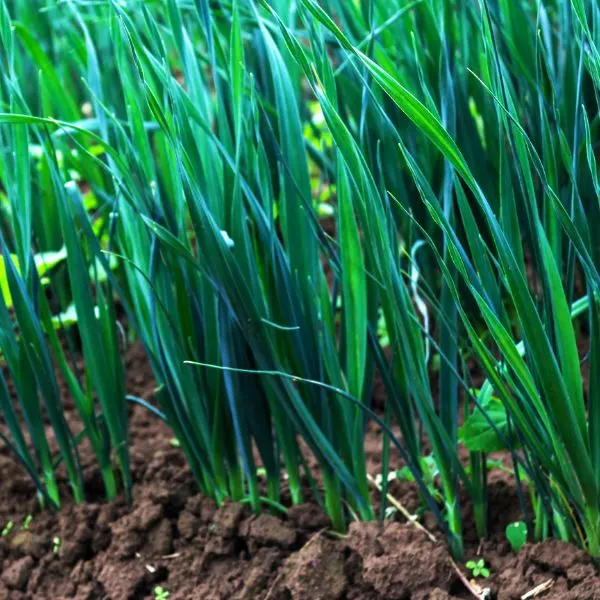
The leek is another flowering plant within the genus Allium. It possesses a large and slender white bulb and flat dark green leaves that overlap. Like other pungent members of its family named in this article, it is used in cooking.
Leeks serve as good companions for cantaloupe because they can help to repel some of the natural predators of this plant, including aphids, cucumber beetles, deer, rabbits and other foraging rodents.
This is due to the possession of sulfur by plants within this genus. The sulfur content of this plant lends it its pungent smell, which most insects hate, and its strong, sharp and stinging taste, which deer and rodents hate.
Because cantaloupe needs to grow under full exposure to sunlight, it needs companions that will not take too much sun away. Leek plants also do well because most alliums tend to grow compactly and hardly shade cantaloupe plants.
Alliums contain allelochemicals which foster the growth of some crops but also cause harm to others. They can stunt the growth of legumes so avoid growing alliums in an area where legumes have already been grown and vice versa.
10. Lettuce
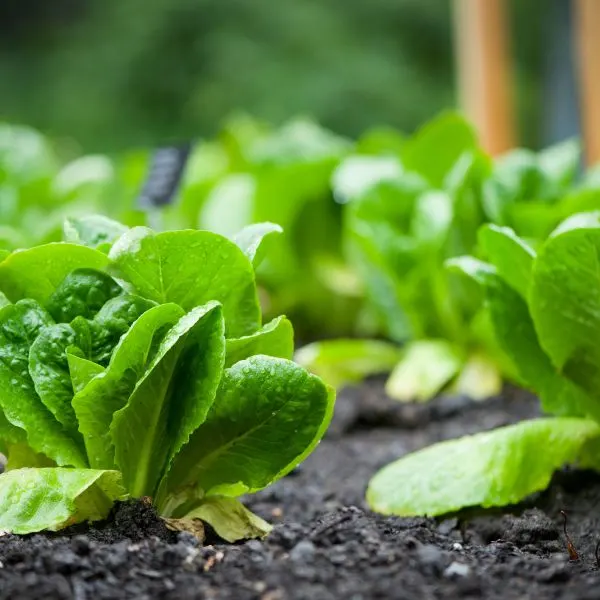
Also grown for its stem and seeds, lettuce is a flowering annual plant in the daisy family Asteraceae mostly cultivated for its leaves and used as a leaf vegetable. It is most often eaten in salads but may be added into other foods.
Lettuce is another good companion for your cantaloupe. The two plants do not inconvenience each other, as they both like full exposure to sunlight, consistent and even watering, and moist but not soggy soil.
They both are flowering plants and so the process of pollination will be fostered. Flowers attract beneficial insects and birds which can help move pollen grains when they feed, thus helping with the reproductive process of the plants.
Cantaloupes need enough root space and adequate garden space to spread their vines. Lettuce plants do not take up too much root (they have shallow roots) or even garden space so they leave ample room for the vines of the melon crop.
Lettuce is also great for weed control. While it has broad leaves, they are compact and because of the shallow roots, it can be grown together in large quantities. This comes in handy by choking out weeds.
It also matures fast, between 2 weeks and 3 months of being planted. It can provide some shade for your cantaloupe in the hotter parts of the day while saving space and protecting the vines from weeds.
By the time the cantaloupe needs to take over that space in your garden, the lettuce would be done growing and even be harvested. Growing lettuce with cantaloupe ensure you have produce to harvest while you wait for the cantaloupe to grow.
11. Marigolds
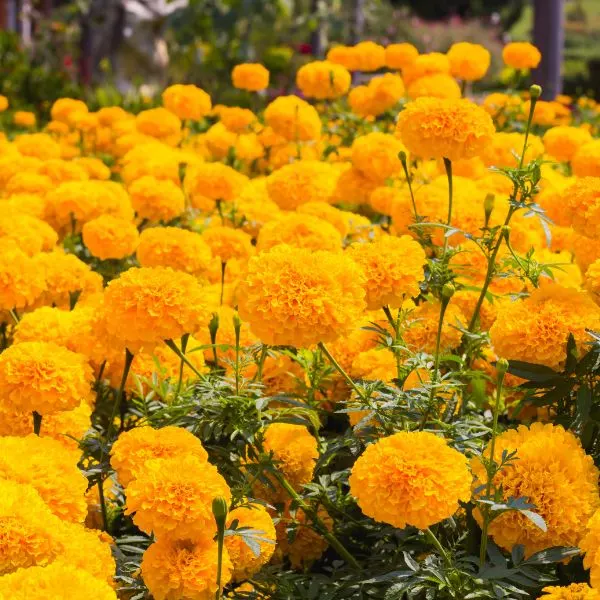
Marigolds are mostly herbaceous flowering annual or perennial plants which belong to the daisy family Asteraceae just like lettuce. They are good companions to Brussels sprouts for these two reasons: their flowers and their odor.
They have bold, beautiful and colorful flowers which come in different sizes and may be gold, orange, white or yellow in color. They also have a pungent odor and have green feather-like leaves.
Marigolds, French marigolds in particular, serve as very good companions for cantaloupes. They have a strong scent that helps to repel most of the insect and animal pests that would otherwise have detrimental effects on your cantaloupe.
They deter certain natural pests of garden crops, like aphids, flies, squash bugs, nematodes, cucumber beetles and white flies. They also possess beautiful flowers which come in a variety of colors and attract useful insects.
With their bright yellow, orange and red flowers, marigolds can positively impact crop yields. This is because they are known to attract butterflies, bees and other helpful insects like pollinators and pest predators to your garden.
Although marigolds may be used to repel harmful garden pests as they always have been, some evidence exists that they also tend to attract certain pests. Some of these are snails, slugs, whiteflies and thrips.
In this case, marigolds may actually be planted around or near cantaloupes and utilized as trap crops. When used as a trap crop, the marigold protects the cantaloupe by attracting pests that would destroy the melon to itself.
Due to the tendency that both plants have to attract harmful insects, marigold should be planted near cantaloupe but not directly in the same bed or within the same container. Plant marigolds along the edge of the garden or in a container that will be placed near your cantaloupe.
12. Marjoram

The herb marjoram may also be referred to as knotted or sweet marjoram to distinguish it from oregano. The flowering herbaceous plant belongs to the mint family Lamiaceae and has pine and citrus flavors.
It has smooth and simple leaves with many hairs. They are wide and ovate to oblong-ovate in shape, possessing linked, meshed or reticulate veins and obtuse apices. Marjoram is a good companion plant for cantaloupe.
Like many other herb varieties, marjoram grows compactly. This means that this plant will most likely not compete with your cantaloupe for space or shade the sun-loving crop from its much needed exposure to sunlight.
Its fragrance and flowers also makes it a good companion. Marjoram has a pungent odor that keeps pests away from the cantaloupe beside it. At the same time, the flowers attract beneficial insects and pollinators to aid reproduction and feed on plant pests.
13. Mint
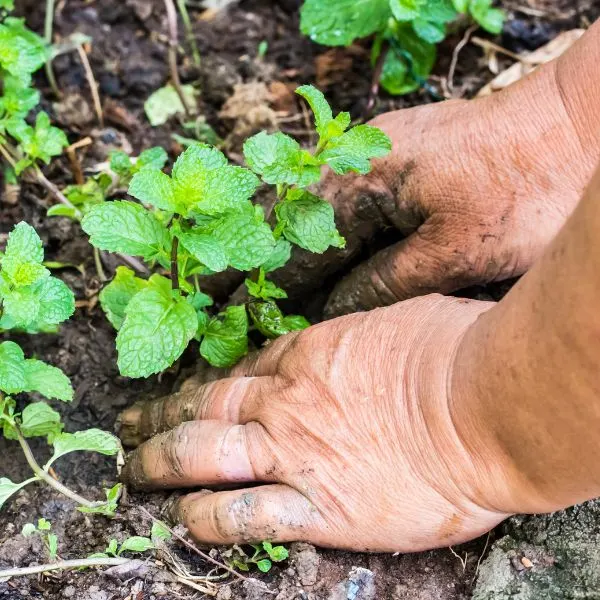
There are about sixty types of mint in the genus which are aromatic herbaceous flowering plants in the biological family Lamiaceae. Most plants in this genus are perennial, with wide-spreading runners under, on or above the ground.
Plants within this genus tend to be good companions for your mint. They have a bold and pungent smell that masks the more subtle smell of the melon crop and so protects it from pests that would rather destroy the plant.
They help repel garden pests like aphids, thrips, mites, and whiteflies. At the same time, these plants have very beautiful flowers that attract pollinators, especially different types of bees and butterflies.
Although there is not much scientific evidence to prove this, mint is believed to help improve the flavor of other crops grown around it. Mint likes to be grown in full to partial shade but you don’t have to bother about its other requirements.
This is because this plant is best grown on its own in a separate container. Mint is a notorious spreader, with quickly spreading horizontal roots. If grown in the same soil as cantaloupe, it will definitely reduce your plant’s yield.
Cantaloupe is a heavy feeder that needs lots of water, space and nutrients for optimal growth and health. Mint competes for these with your crop so plant it in a different container placed nearby. This way the benefits are gotten without the disadvantages.
14. Nasturtium
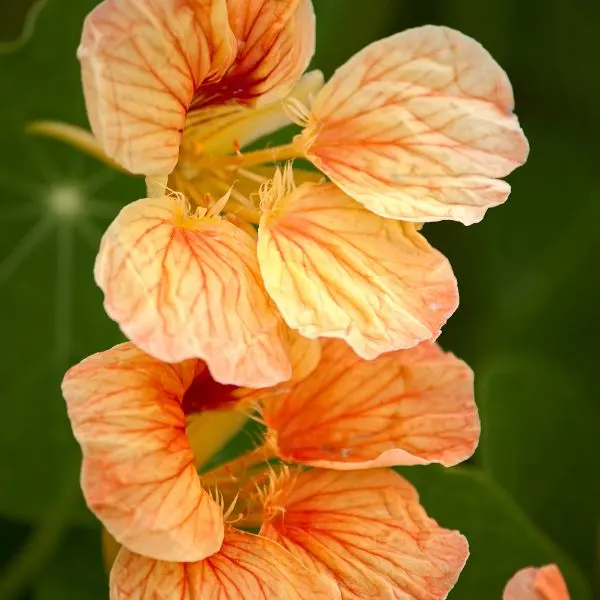
Also known as tropaeolum, nasturtium is a genus of plants that contains several creeping herbaceous plants which may be annual or perennial. These plants have showy round flowers and may be used in herbal medicine or cooking.
Nasturtium is another very suitable companion plant for your cantaloupe. It is a natural powerful and effective pest deterrent; very powerful and effective. In addition to serving as a trap crop, it may also boost the flavor of plants near it.
When planted with cantaloupe or other crops like broccoli and tomatoes, it repels pests that easily and frequently attack the aforementioned. Some of these insects are aphids, squash bugs and striped cucumber beetles.
Nasturtium does attract certain harmful insects such as ants, leafhoppers, squash beetles, armyworms, flies, mites and whiteflies but it attracts them to itself. In the process, it helps reduce the effect of these pests on your cantaloupe plant.
The crop also attracts predatory insects that feed on the plant pests while aiding pollination. Examples are bees, butterflies, hoverflies and parasitoid wasps. It brings them to your garden by its beautiful, vibrant red and orange flowers.
Not only are the flowers attractive to beneficial insects and pests, they simply make your garden more aesthetically pleasing. Nasturtiums are easy to grow, with a peppery scent that can ensure pests are kept at bay.
It is also believed that nasturtiums can improve the flavor profile of your cantaloupes, and contribute positively to their health and growth in general. Plant them near but not directly beside the cantaloupe plant for optimal effect.
15. Onions
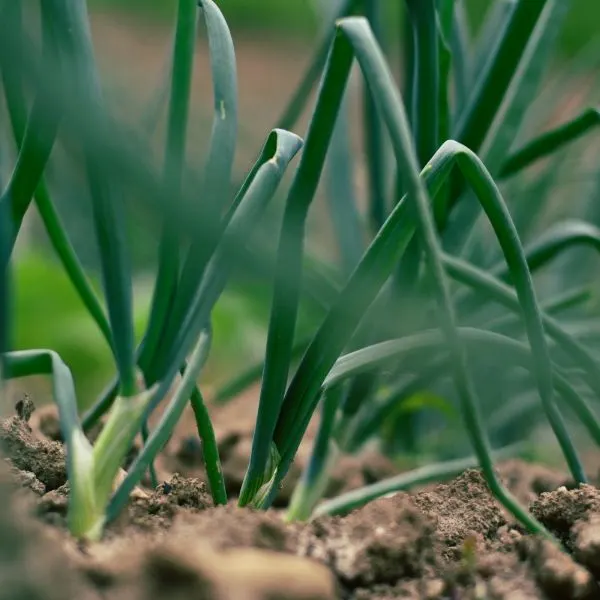
An onion a flowering plant in the genus Allium with bluish green leaves and a bulb at its base. This bulb is made up of shortened underground stems and fleshy modified leaves. Onion is the most widely cultivated vegetable in its genus.
It is also called the common onion. Onions and cantaloupes thrive in similar environments and so they are good together. Both plants need to be directly exposed to full sunlight. They also require lots of moisture and rich, well draining soil.
This allium is also repellent to natural pests of cantaloupes and other melon plants: aphids and cucumber beetles mostly. In addition, deer, rats, rabbits and other rodents can be kept away from your melon patch.
It does so because of its high sulfur content. Sulfur is both an insecticide and a fungicide, meaning that onions can perform both the functions of deterring pests and preventing fungal diseases from affecting your crops from within the soil.
Moreover, onions have shallow roots that do not compete for soil space or nutrients with the deeper roots of cantaloupe plants. They also do not shade your plant because they have a compact growth pattern.
As stated before, legumes and alliums are both good as companions for cantaloupe but not for each other. Because alliums can stunt the growth of leguminous plants, do not plant crops within both of these families in the same vicinity.
16. Oregano
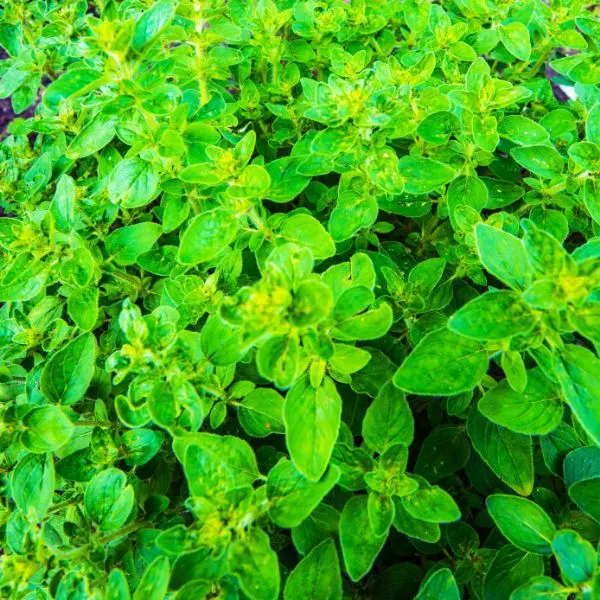
Oregano is a woody perennial plant that belongs to the mint family Lamiaceae. It is a herbaceous flowering plant, which means that it is an aromatic plant with a strong odor and it produces flowers by which it reproduces.
Like a lot of other plants in the mint family, oregano is a good companion plant for your cantaloupe. As a flowering perennial plant, it may be harvested after a single growing season but its flowers may not have bloomed yet.
When allowed to blossom, the beautiful flowers of the oregano plant draw several beneficial insects to your garden. They may be agents of pollination, like bees and butterflies, or predatory ones like ladybugs that feed on crop pests.
The flowers of the oregano plant may be pink, pinkish purple, purple or white. They are an attractive addition to your garden, possessing the ability to bring useful insects and animals to the garden even while keeping pests away.
Hummingbirds, green lacewings and ladybugs are some beneficial animals that the flowers of oregano attract. They are all great pollinators for your plants and they also prey on several pests of cantaloupe, including aphids and beetles.
Hummingbirds eat flies, ants, aphids, mites, beetles, weevils and mosquitoes. The larvae of lacewings are ferocious predators of aphids. Ladybugs feed on aphids, mealybugs, thrips, maggots, mites, beetles and whiteflies.
Even without its flowers, oregano is beneficial to cantaloupe. The strong, pungent smell of the oregano itself is able to keep some pests away. Oregano is also a lover of sunlight but it has moderate water needs and is even tolerant of low moisture conditions.
Both plants have very similar growth requirements. They both prefer to be grown in full view of the sun and they undergo stress in soggy soil. While oregano is drought tolerant, your cantaloupe prefers to be watered regularly.
17. Peas

Peas are herbaceous flowering annual plants in the same biological family as beans, Fabaceae. Also known as garden peas, these plants are cultivated in various parts of the world for their edible seeds. They are not vegetables but they are cooked as such.
Like beans, they are leguminous plants, meaning that they fix nitrogen in the soil. They replenish used-up nutrients in the soil this way, so they are very crucial and effective for heavy feeders like cantaloupe.
Peas and other leguminous plants have nodules in their roots that help fix atmospheric nitrogen in the soil. They improve the quality of the yield of other plants because they supply nutrients to the soil.
There are two varieties of peas: bush or dwarf peas, which do not grow too tall, and vining or climbing peas that grow much higher. It is more ideal to plant bush peas with your cantaloupe to maximize the space in your garden.
Bush peas do not block off the sun from your vining melons but instead give them enough room to spread out and grow well. Peas and cantaloupes are also comfortable together because of their different root types.
As opposed to the deeper roots of cantaloupe, the pea plant has shallow roots that do not compete for water, soil space or soil nutrient. However, peas do not like full exposure to direct sunlight but rather prefer cooler and more shaded areas to grow and mature properly.
An important thing to note is that legumes and alliums are not the most compatible families to be planted together in the garden bed. However, plants within these families are very good companions for cantaloupe.
If you are planting peas near your melon crop, avoid growing any alliums in that area. Do not also add peas or any other legume to the companionship if alliums are already growing with your cantaloupe.
18. Radishes
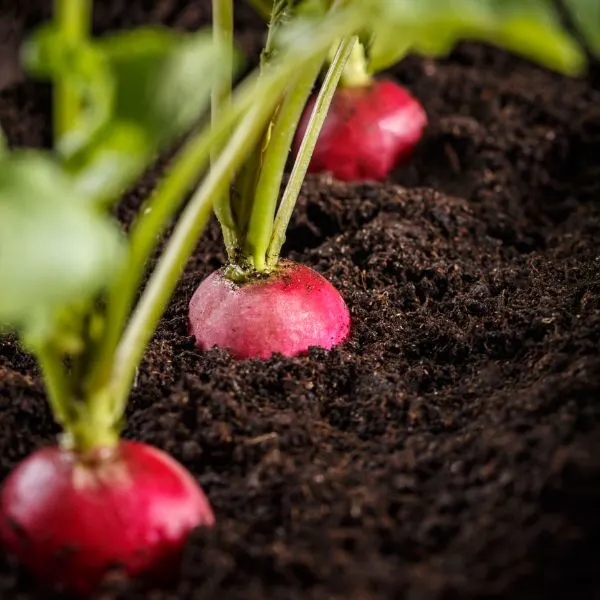
A radish is a root vegetable belonging to the biological family Brassicaceae, the cabbage family. Its roots are edible and so are the leafy greens atop them. They may be eaten raw, which they mostly are, or cooked.
There are several cultivars of radishes in different colors, sizes and shapes. The edible roots and green leaves above it are typically eaten raw as a salad vegetable or with other foods after being cooked by several cooking methods.
Radishes need care and nutrients similar to those that cantaloupes need. They are very suitable companion plants for cantaloupe for this reason and many more. Both crops are comfortable with full sun and moist, well-draining soil.
Another reason they are beneficial is that they help to loosen the soil surrounding your cantaloupe plants. This allows the plants more room to absorb the water and nutrients that they need a large quantity of.
Radishes also need lots of nutrients and water to grow very well and so it is likely to be a competitive environment for the cantaloupes if they have to grow in the same soil. This issue can however be solved by adequate spacing.
Animal and insect pests, including aphids, cabbage loopers, cutworms, deer and flea beetles attack radishes and some of these are also attracted to cantaloupes. Other measures may be put in place for the purpose of pest control.
For example, tansy may be added to the companionship. The plant attracts predatory insects like ladybugs and lacewings. So when the aphids attracted to cantaloupes and radishes come around, these insects feed on them.
Because both plants are flowering crops, they help improve the growth and vigor of each other. By their flowers, they can attract useful pollinators to the garden to aid the development of your melon crop.
Radishes are also beneficial because they grow and mature quickly. This means that they are able to serve as ground cover and help suppress weeds, and still be harvested before your cantaloupe needs the space to spread more.
19. Sage
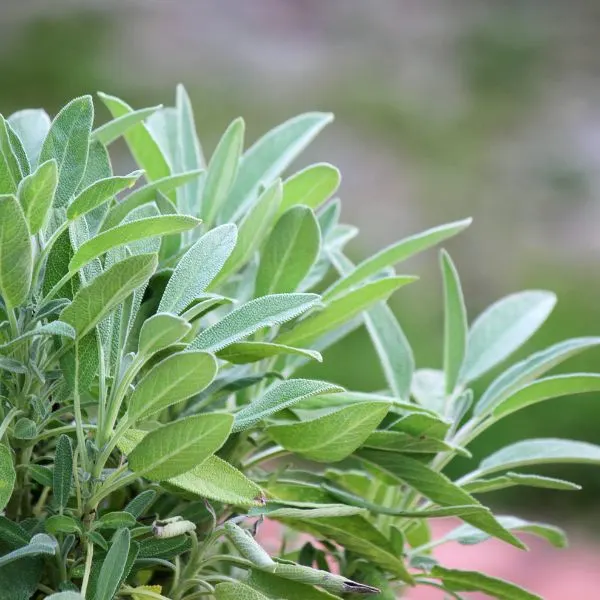
Sage is another perennial flowering plant in Lamiaceae, the mint family. This aromatic herb has woody stems, stunning blue to purple flowers and distinct grayish green leaves. It is grown mostly for use as a culinary spice or a medicinal herb.
This herb is able to attract pollinators with its flowers while keeping pests away with its scent. Sage is also easy to grow and grows comfortably near cantaloupes. It will thrive both ways, whether planted under full sun or in partial shade.
It however appreciates direct sunlight more, so the pairing is ideal considering that cantaloupes also love full exposure to sunlight. Both plants prefer moist, well drained soil for their growth. Sage is however drought tolerant and prefers to be watered less than overwatered.
When in bloom, sage attracts pollinators, including butterflies, hummingbirds and bees. As a natural pest control herb, it is also able to repel beetles, cabbage moths, carrot flies, flea beetles, snails and cantaloupe’s worst pests: aphids and cucumber beetles.
20. Shallots
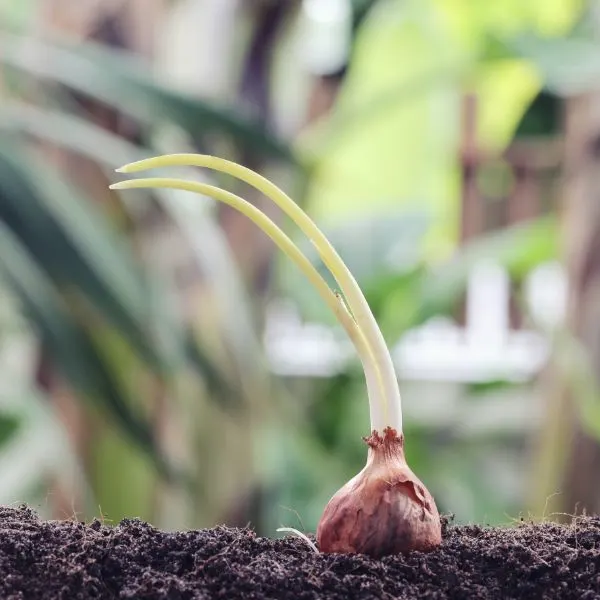
The shallot is a variety or cultivar of the onion. It was once on its own, classified as a separate species, but because the difference between shallots and common onions was too small for grouping as a separate species, both were merged.
Shallots are used for culinary purposes. They may be deep-fried or pickled and used as condiments in several cuisines around the world. They taste like the common onion but with a milder flavor.
Like onions, raw shallots release substances that irritate the human eye when they are sliced. As an allium, the shallot contains a lot of sulfur. It is a very suitable companion plant for cantaloupe.
Shallots help repel aphids, cucumber beetles, deer, rabbits and other insects or rodents. They keep these garden pests away from your melon patch, ensuring that the cantaloupes have a healthy, pest-free environment to grow well in.
They also do not take up too much sunlight or shade your plant excessively from the sun. This is because they grow compactly. They also do not compete for the space that your cantaloupes really need to spread in.
Alliums in general have more shallow roots than melons, gourds or cucurbits (these are all names used to refer to the family cantaloupes belong to). This difference in root size and depth makes for much less chance of competition for water, soil nutrients and root space.
Legumes and alliums are both good as companion plants for cantaloupe but not for each other. Because alliums can stunt the growth of leguminous plants due to allelopathy, do not plant crops within both of these families in the same vicinity.
21. Spinach
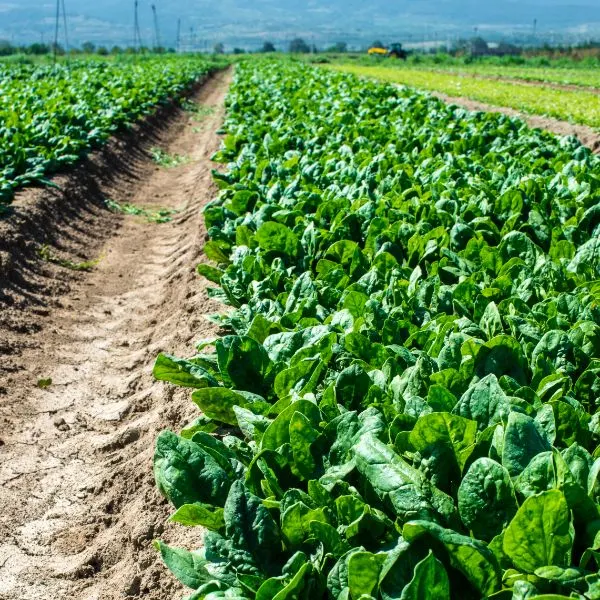
Spinach is a flowering plant in the amaranth family. Its green leaves are edible and commonly eaten as a vegetable either raw or after preservation. Spinach is a good companion plant for cantaloupe.
Although it does not necessarily add much to your plant, its roots grow to a different soil level than those of your melon. The both species also have different nutrient requirements. For these reasons, spinach does not compete with your crop.
Instead, they live and grow peacefully when planted next to each other. Also, spinach serves as a good ground cover, filling holes and spaces within your garden. This maximizes the potential and space of the garden.
Like lettuce, spinach matures fast and is a great companion for cantaloupe and other melon plants. The plant can be cultivated in the melon patch, interplanted with cantaloupes for beneficial reasons.
Spinach helps with weed control within the area and provides some shade during the hotter parts of the day. Because it matures fast, it can serve its purpose and be harvested from the garden before the cantaloupe needs the space to spread.
22. Sunflower

A sunflower is any species of annual and perennial plants that belong to the genus Helianthus in the family Asteraceae, the daisy family. They bear flowers which have large heads, dark disk florets and flamboyant yellow rays.
Sunflowers are great companion plants for cantaloupe and other gourds within the family. Cantaloupe can benefit this plant as much as it receives benefits itself. Companionship between these two may also become detrimental.
The cantaloupe plant grows long vines with large leaves and these help retain the moisture content of the soil while also crowding out and controlling any weeds that may otherwise spring up and battle for nutrients.
Sunflowers benefit cantaloupes by boosting pollination, which means increased reproduction and improved crop yield. They possess beautiful and showy yellow flowers which attracts birds and pollinating insects.
Adequate spacing should be observed between sunflowers and cantaloupes. This is because the sunflower plant is very attractive to aphids, and aphids are a very serious problem for cantaloupe.
23. Tansy
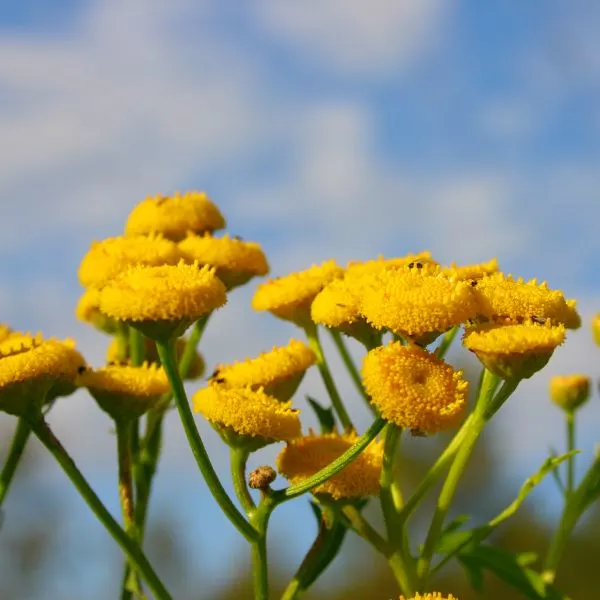
Tansy is a perennial herbaceous flowering plant in the aster family Asteraceae. This aromatic plant is native to Eurasia, characteristically having yellow button-like flower heads and leaves which have a bitter taste. It may be used medicinally.
The flowers and leaves of tansy can both deter pests and bring useful insects to the area. As a flowering plant that intends to yield fruit, your cantaloupe can benefit from these qualities and abilities of tansy.
When planted with cantaloupe, tansy can control some of its pests like ants, aphids, cucumber beetles, flies and squash bugs. It does so by attracting predators of these pests. These include minute pirate bugs, hoverflies, lacewings and parasitoid wasps.
Butterflies, honey bees, wasps and ladybugs are insects that aid pollination, will likely come to your melon patch because of the attractive flowers of tansy. They will help with the plant’s reproductive process and boost its health.
If you have grown tansies near your cantaloupe and they have grown too large, it is advisable to cut them back. After being cut down, the tansies can be dried and used as pest control spray or a fly repellent within the house.
Bad Companion Plants for Cantaloupe
1. Broccoli
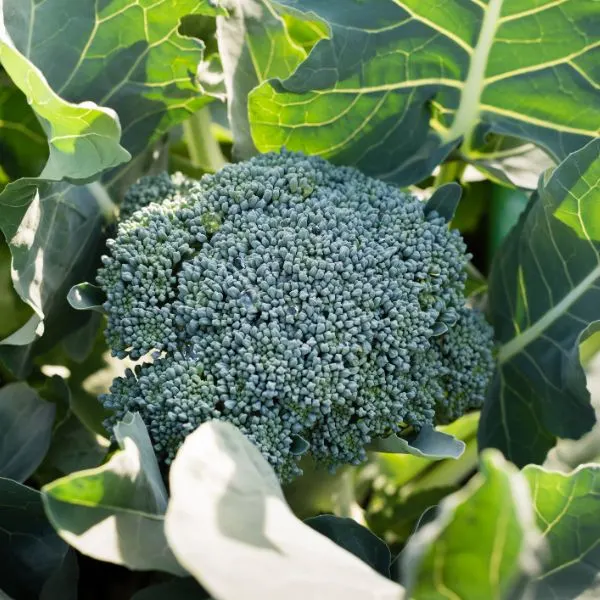
Broccoli is a flowering plant in the family Brassicaceae, the cabbage family. It has large, partly developed green flowers that make up its head, stalks and leaves which are the edible parts of the plant, the main reason it is cultivated.
Even though they both have the same care and nutrient requirements, avoid planting broccoli and cantaloupe side by side within the same soil. Broccoli is a bad companion plant for cantaloupe, as are other brassicas.
Although broccoli provides good ground cover and helps fill empty spaces in your garden, it has a tendency to battle for soil nutrients with cantaloupe. This is because both plants are heavy feeders and so require more nutrients than most other plants do.
In addition to needing lots of and competing for similar nutrients to your cantaloupe, broccoli attracts several pests that also harm the melon to itself. If you must grow both of them, the crops should be kept away from each other with good companions between them.
2. Brussels Sprouts
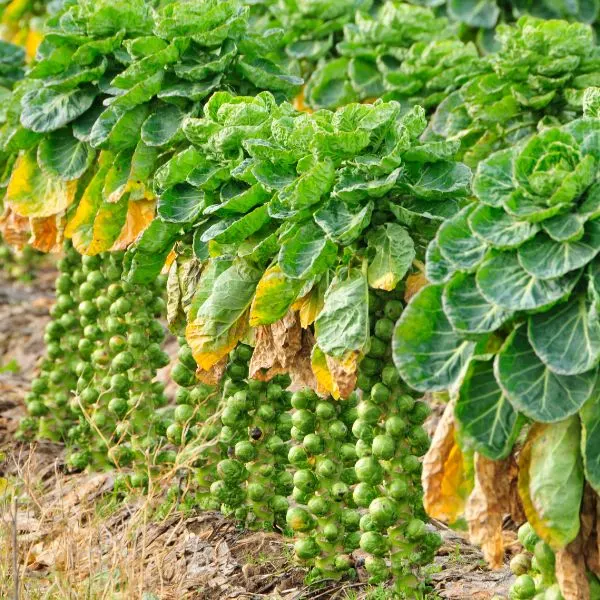
Brussels sprouts are flowering plants in the cabbage family grown for their edible buds. They are green leafy vegetables resembling very small cabbages. As brassicas, they are also very bad companion plants for cantaloupes.
Growing them together would be easy because they both need similar amounts of light, water and nutrients. Both crops love rich, moist but well drained soil, full sunlight exposure and frequent watering.
This however leads to more problems than benefits because it means that both crops would battle for water, nutrients and space in the soil. They are both heavy feeders and would be adversely affected by this relationship.
Because brassicas and melons are susceptible to attacks from some of the same pests, one of two possibilities may occur. Pests may be more attracted to that area of your garden, causing more damage, or the damage may reduce, evening out between the crops.
3. Cauliflower
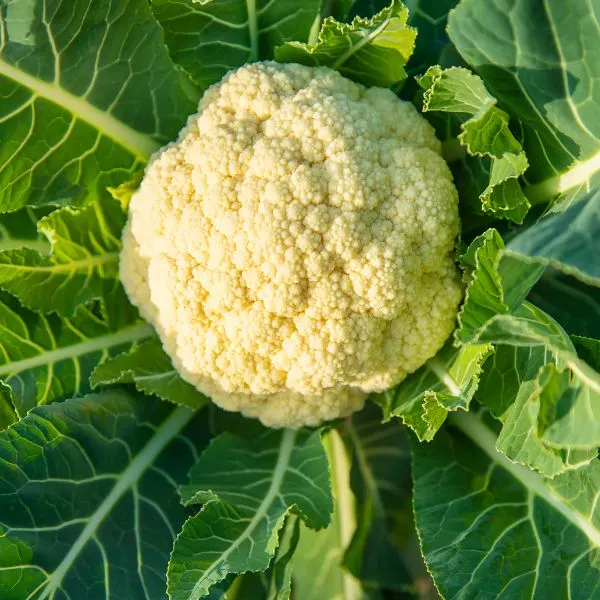
Cauliflower is another flowering plant in the Brassicaceae family, cultivated for its partially developed flowers, referred to as the head or “curd”. The head is edible and mostly in the colors white, yellow, green, orange, brown or purple.
This brassica is also a bad companion plant for cantaloupe. Even though both cauliflower and cantaloupe like to be grown in similar conditions, they both need larger amounts of water and nutrients than usual for maximum yield.
More problems than benefits will arise from cultivating both these heavy feeders together as they would be in competition which is both unhealthy and unnecessary, for water, nutrients and space in the soil.
In the area of pests and diseases, conflicting views exist. The members of both these families — brassicas and cucurbits— are susceptible to attacks from aphids, beetles and whiteflies. The companionship may turn out one of two ways.
The common pests may become more attracted to that area of your garden, your melon patch, in the process causing more damage. The damage may also reduce, evening out between the both crops.
4. Cucumber
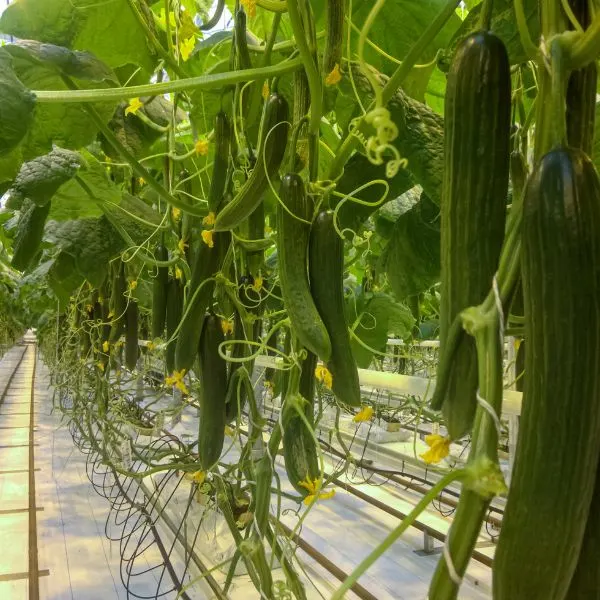
Another bad companion plant for cantaloupe is the cucumber. Cucumber is a creeping vine plant considered an annual crop. The plant produces mostly cylindrical green fruits used in cooking as vegetables, usually eaten raw or pickled.
This flowering plant also belongs to the cantaloupe’s family Cucurbitaceae. Planting lots of crops within the same family, especially brassicas and gourds which are heavy feeders, is not the best idea in gardening.
Both cucumber and cantaloupe plants have similar growth needs. Cucumbers can tolerate partial or full shade but they prefer exposure to direct sunlight for six to eight hours daily. They like lots of moisture and should be watered regularly.
Companionship is not ideal because cucumbers compete with your cantaloupe for soil nutrients and sunlight. Like the cantaloupe, cucumber is a heavy feeder that ends up taking up the nutrients, nitrogen for example, that are much needed.
In addition to taking nutrients away from the soil, cucumbers strive for sunlight. Regardless of the plant beside them, they are so competitive that they make sure they get enough light and nutrients.
Cultivating cantaloupe beside such a competitive plant when the crop itself is heavy feeder evidently does not produce great results. The crop may not survive this competition, leading to malnourishment and consequently, poor yield.
One plant may end up doing much better than the other, suffocating it in the process, or both of them will be stunted. Either way, the relationship is not optimal; it does not ensure both plants are thriving and healthy.
Cucumber beetles and several other pests are attracted to both these crops. Planting them side by side is an invitation to these pests. They will constantly competing for light, water and nutrition so grow them far away from each other in the garden for optimal results.
5. Kale
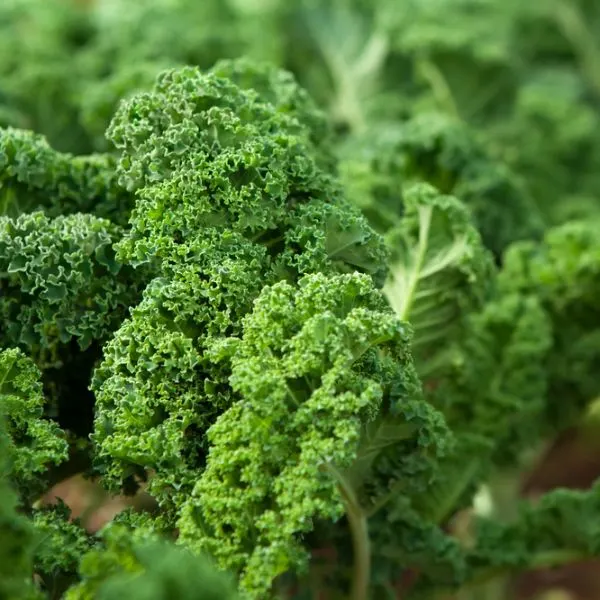
Another brassica that should not be planted near your melon plant is kale. Kale, also called leaf cabbage, is a cabbage cultivar grown for its edible green or purple leaves, or for use as an ornamental plant. It is a bad companion for this plant.
Although kale can deter pests from attacking your cantaloupe vines, it is a heavy feeder too. It would battle with your plant for the nutrients and space in the soil. Also, they attract the same pests and can easily share diseases.
6. Kohlrabi
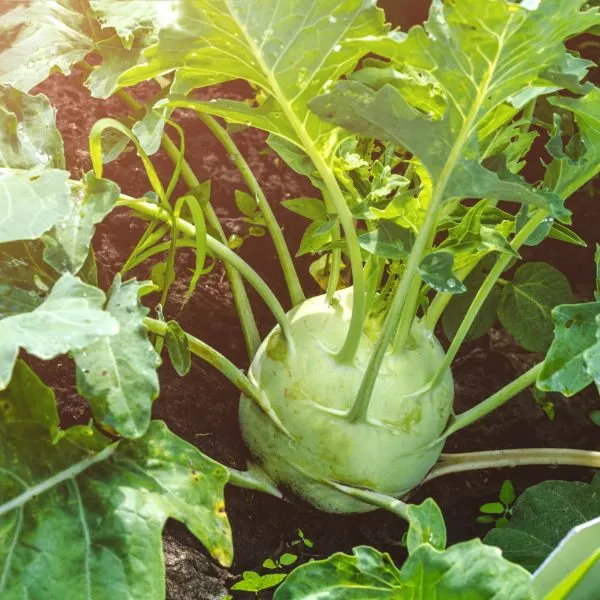
Yet another plant you should not grow with your cantaloupe is kohlrabi. It is a variety of wild cabbage with thin stems and yellow flowers also known as the German turnip. Its stems and leaves are edible and it tastes very much like cabbage.
As with other plants within this cabbage family, separate the cantaloupe from kohlrabi. This avoids the unnecessary and unhealthy competition for root space and soil nutrients that would otherwise occur if they are planted side by side.
The companionship would be ideal and comfortable because they both need similar care for their development. However, pests and diseases will be easily distributed and transmitted in such an area in addition to the competition. Both plants would not fare well, or one would thrive while the other dies.
7. Potatoes
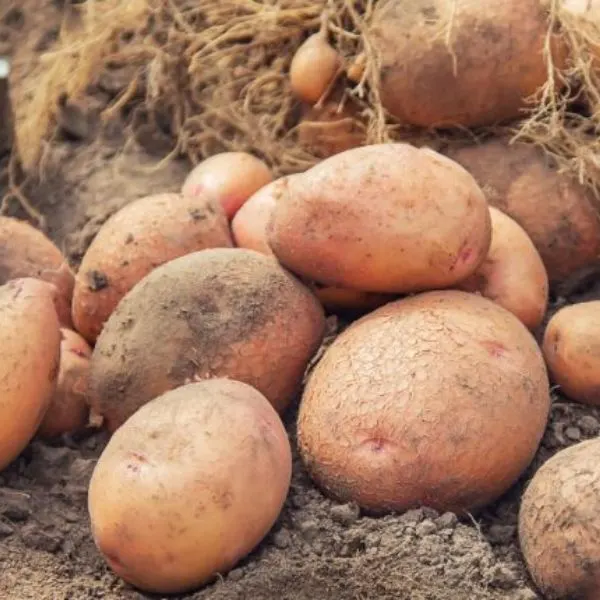
Potatoes are perennial root vegetables belonging to the family of nightshades known as Solanaceae. They are starchy tubers with their vegetative and fruiting parts toxic for human consumption (because they contain a toxin solanine).
They are bad companion plants for your cantaloupe. Both potatoes and cantaloupe need many nutrients from the soil for proper development. This companionship will not be beneficial in any way.
Keep potatoes far away from your cantaloupes because they will most likely compete with each other for most of the important factors needed for healthy growth and high yield. These include sunlight, root space and nutrition.
Although potatoes are good repellents of deer, there are a lot of consequences that outweigh whatever few advantages there may be. Another one is that the roots of potatoes begin to rot if the soil is too moist.
This is inconvenient because cantaloupes actually appreciate high levels of soil moisture. Also, potatoes attract aphids, flea beetles, spider mites, mice and other rodents. These pests destroy both crops so each of them should be grown beside other crops that can help protect them against pest activities.
8. Pumpkin
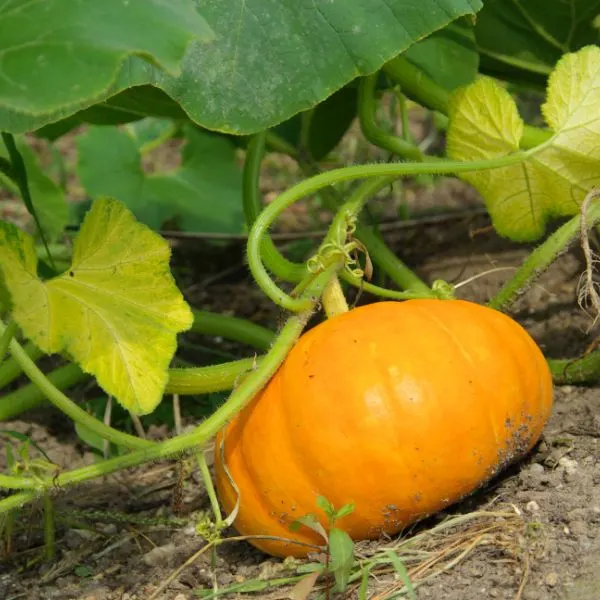
Pumpkins are cultivars of winter squash (fruits of plants in the genus Cucurbita that have hard rinds, mature in winter and may be stored for several months) that are round in shape and ribbed on their skin. They have deep yellow to orange skin and inside, they contain seeds and pulp.
These plants are not good companions for cantaloupe as they sprawl in search of sunlight and quickly overtake other plants close by, shading them too much in the process. Your melons also need lots of sunlight.
Growing them together ensures that your cantaloupe does not get as much sunlight as it requires. This competition is so unhealthy because sunlight is paramount for the growth and health of your plant by photosynthesis.
In addition to stealing sunlight from your cantaloupe, pumpkin is also a member of the Cucurbitaceae family. This means that it is a heavy feeder and it also attracts cucurbit pests like cucumber beetles and squash bugs.
So the pumpkin, if planted beside your cantaloupe, can begin another unhealthy competition for nutrients, water and space. It also ensures that the plant’s yield is negatively affected by the host of common pests that it attracts.
9. Squash
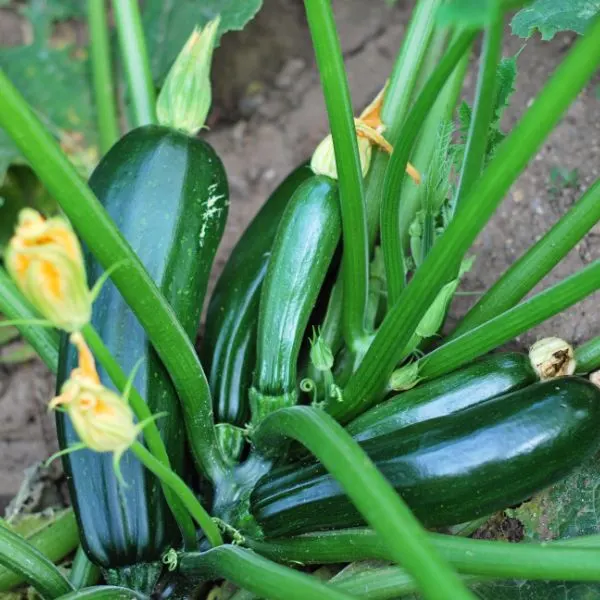
Squashes are herbaceous vegetables in the Cucurbitaceae family, the gourd family. This genus comprises many different species grown to be consumed as vegetables. They are very bad companion plants for cantaloupe.
These plants have long taproots but the rest of their roots are short. As a result, they need a constant water supply in order to grow and maximize yield. They also enjoy full sunlight for about 6 hours daily to develop properly.
Although they enjoy the same growing conditions as your cantaloupe, they should not be planted side by side. They should be planted in separate rows within your garden if both crops must be present in your melon patch.
Squashes are also members of the gourd family. They take up lots of soil nutrients, need adequate space to sprawl and love lots of sunlight. Once again, growing these two plants in the same family results in unhealthy, avoidable competition.
Another reason squashes must be kept far away from your cantaloupe is that both plants attract the same or similar pests to the garden. Both are loved by cucumber beetles and squash bugs.
10. Watermelon
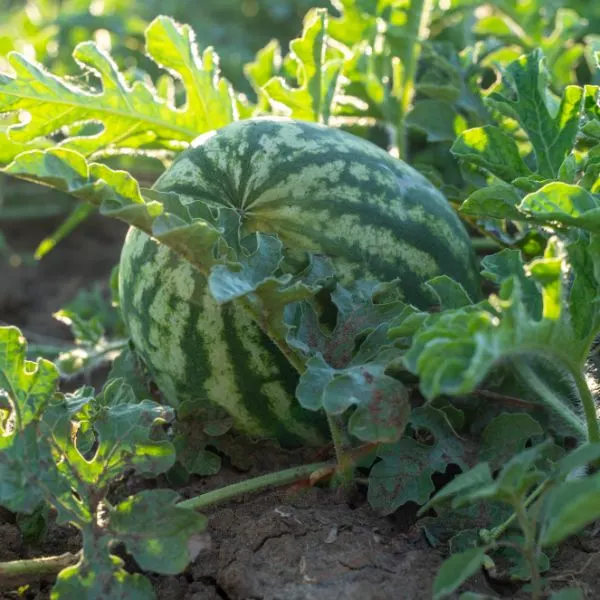
Watermelon is the name of a flowering plant species which belongs to the gourd family Cucurbitaceae and the name of the edible fruit that the said plant produces. There are over a thousand varieties or cultivars of this popular plant.
Just as other plants within its family, the watermelon is a vining, scrambling, sprawling or trailing plant. Its fruit has a sweet and juicy flesh that is usually deep red to pink with lots of black seeds. It may be eaten raw or pickled.
Regardless of whatever reason you may be tempted to, do not ever plant watermelon beside cantaloupe. Each of these plants hinders the growth of the other. To reiterate, plants that are in the same biological family, especially brassicas and cucurbits, should not be planted together.
They have the same or similar growth needs, which are a lot actually, so they compete for sunlight, space and nutrients. Also, they attract similar pests like aphids, cucumber beetles and squash bugs so planting cantaloupe and watermelon near each other makes the area more appealing to the pests.
FAQs
What can you not plant with cantaloupe?

Ten bad companion plants that you should not plant with cantaloupe include broccoli, Brussels sprouts, cauliflower, cucumber, kale, kohlrabi, potato, pumpkin, squash and watermelon.
Can watermelon and cantaloupe be planted together?
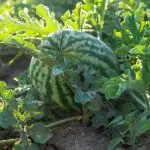
No, watermelon and cantaloupe should not be planted together. They would compete for root space, sunlight and soil nutrients, even while attracting the same kind of pests if grown side by side.
Can I plant onions near cantaloupe?

Cantaloupes generally like alliums so yes, you can plant onions near cantaloupe. Onions naturally repel certain pests of your melon plant and do not fight with it for space, light or nutrients.
What grows well with melons?
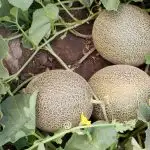
Alliums (like chives, garlic, leeks, onions and shallots), asters (like lettuce, marigolds, sunflowers and tansy), legumes (like alfalfa, bush beans, lentils and dwarf peas) and herbs (like basil, bee balm, catnip, marjoram, mint, oregano, rosemary and sage) tend to grow well with melon crops.
Can I plant cantaloupe next to tomatoes?
Yes, you can plant cantaloupe next to tomatoes. They are compatible as companion plants because they share similar growing requirements and do not compete for resources.
Additionally, tomatoes can provide some shade for cantaloupe vines, which can be beneficial in hotter climates.
Can you plant cucumbers and melons together?
Yes, you can plant cucumbers and melons together. They are part of the same family, Cucurbitaceae, and have similar growing requirements. Planting them together can help save space in the garden and promote healthy growth, as they share similar water, sunlight, and nutrient needs.
Is it better to grow cantaloupe on the ground or trellis?
Growing cantaloupe on a trellis is usually a better choice than letting them sprawl on the ground. A trellis offers some nice perks, like better airflow, fewer pests and diseases, more sunshine, and easier picking.
Just remember to give those growing melons a little support with slings or mesh bags to keep them from falling or getting hurt by their own weight.
Conclusion
Cantaloupes are a variety of muskmelon species in the gourd, cucurbit or melon family Cucurbitaceae. Listed and explained above are twenty-three (23) good and ten (10) bad companion plants for these crops.
They provide several vitamins and minerals, including the vitamins A, B1 (thiamine), B2 (riboflavin), B3 (niacin), B5 (pantothenic acid), B6, B9 (folate), C and K, calcium, choline, iron, manganese, magnesium, phosphorus, potassium, zinc and sodium.
In addition to the many nutrients they contain, cantaloupe is high in fiber, water and antioxidants. It is a superfood, low in calories but high in vitamins and minerals. The properties it contains can help to reduce high blood pressure.
Cantaloupe is rich in Vitamin C, zeaxanthin and carotenoids which improve vision and reduce the risk of eye problems and defects. It boosts the immune system and is also good for the skin (because they contain beta-carotene which the body converts to Vitamin A).
While growing them, remember that cantaloupes need full exposure to sunlight, moist and well draining soil, cool weather and even, intervallic watering for their soil. They are heavy feeders so avoid planting other members of their botanical family Cucurbitaceae.
More companion plants
